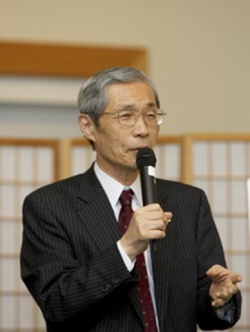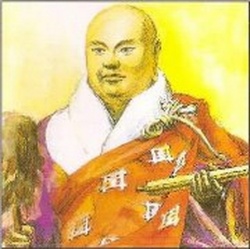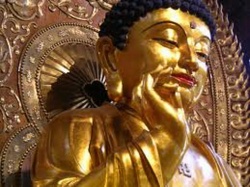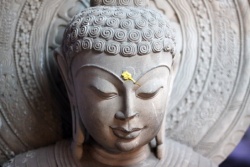Nichiren Buddhism and Empowerment
Yoichi Kawada, director of The Institute of Oriental Philosophy, Tokyo
(August 26, 1999, at the American Psychological Association Convention, Boston, USA)
Nichiren is the 13th-century Japanese Buddhist teacher whose teachings inspire the activities of the SGI. In this paper I would like to explore areas of contact between Nichiren Buddhism and the idea of self-empowerment.
Nichiren himself was thoroughly versed in the intellectual history of Buddhism. His understanding was rooted in the Sutras recording the teachings of Shakyamuni, and drew from the theories and exegeses of the Indian scholars Nagarjuna (c. 2-3 century C.E.), Vasubandhu (5th-century C.E.), the Chinese Buddhist T'ien T'ai School, and Japan's Saicho (8th-century C.E.). Thus, in discussing empowerment, I will start by exploring points of contact between modern Western psychology and the "eight consciousness" theories developed by Nagarjuna and Vasubandhu, and adopted and developed by T'ien T'ai and Nichiren.
It was the historian Arnold Toynbee who said that the two great discoveries of this century were the theory of relativity in the realm of physics and the work of uncovering the unconscious in the realm of psychology. He further remarked that the discovery of the unconscious revealed that each individual is in fact a cosmos, a universe.
Credit for the discovery of the unconscious in Western psychology goes to Freud, whose work was followed by Adler, Jung, Maslow and others, who have dramatically extended our exploration of the psychic cosmos.
In the East some 2,500 years ago, Shakyamuni, widely known as the Buddha, creatively adapted and recast the ancient philosophy of the Upanishads as he developed his own philosophy. His awakening as he meditated beneath the bodhi tree may be considered a seminal event, a critical moment, in Eastern psychology. This awakening started with his insights into his own unconscious and expanded to illuminate a vast psychic cosmos.
His exploration of his inner world, this inner cosmos, moved beyond the individual level, deepening eventually to include all humankind. He continued to explore the bounds of selfhood, from commonality of all living things, to those depth realms where the self is fused with the Earth, the solar system and the entire universe. He finally awakened to the fundamental wisdom of life, the life of the universe itself, which gives rise to all phenomena as they evolve in harmonious unity with the psychic cosmos.
Later practitioners would refer to the cosmic [[life-force to which Shakyamuni awakened as the Buddha-nature. They would explore means and methods of practice by which all people can manifest the vast energy, dignity and wisdom of this life-state; methods, in other words , of self-empowerment.
A Three-Layered Structure of Consciousness
Here I would like to give a brief outline of the eight consciousness teaching that forms an important basis of Buddhist psychology.
The word that is translated as consciousness is the Sanskrit vijñana, which indicates a wide range of activities include sensation, cognition, affect and conscious thought. Vijñana can be thought of referring to the entire psychic cosmos.
According to the Yogacara School, vijñana comprises three layers:
1) the five senses and waking consciousness;
2) the mano consciousness; and
3) the alaya consciousness, with the alaya being regarded as the most core, or fundamental site of psychological activity.
In other words, the content of the alaya layer makes it self known, and becomes manifest, in the activities of the mano layer, as well as in the five senses and the waking consciousness. Conversely, the activities of the more superficial layers are inscribed in the depths of the alaya consciousness. There is thus a constant and intimate interaction between the different layers of consciousness.
It should also be clarified at this point that the alaya consciousness should not simply be understood in an ontological sense, as existing, but as embracing a cognitive and even an ethical dimension.
The mano and alaya layers of consciousness in many senses correspond to the individual and collective unconscious in Jungian psychology.
I would like first to look at the mano consciousness, which is described as emerging from the alaya consciousness and as being focused in its "attention" on the alaya consciousness.
In this sense, the mano layer can be understood as the seat of the most basic consciousness of self. The Sanskrit verb from which this derives is manas, meaning to think or to consider. Thus the mano consciousness is always thinking about, considering, and in fact reifying the alaya consciousness of the individual, which it perceives as something unique and isolated from other things. It is from this strong attachment, or clinging, to a reified alaya consciousness that mano consciousness generates the sense of a limited, isolated self referred to in Buddhism as the lesser self.
When the mano consciousness functions in this manner it gives rise to a series of powerful delusions that manifest in the other, more immediate layers of perception and consciousness as attachment to and pride in this proscribed sense of selfhood. The delusion that the reified alaya conscious is one's true self is identified with fundamental ignorance, a turning away from the truth of the interconnectedness of all being. It is this sense of one's self as separate and isolated from others that gives rise to discrimination against others, to destructive arrogance and acquisitiveness.
The lesser self is deeply insecure, and vacillates between feelings of superiority and inferiority with regard to others; in the pursuit of its own fulfillment, the lesser self will unthinkingly harm or wound others. When the mano consciousness is filled with these delusions about the nature of the self, they give rise to a whole series of delusions that the early Buddhist took great pains to name, number and classify, but which I will omit here in the interest of time. Suffice it to say that the mano consciousness functions to create a strong sense of disjunction between self and others and to generate discriminatory attitudes towards those we experience as "other."
Characteristics of the Alaya Consciousness.
In the Trimsika-vijnapti, Vasubandhu ascribes the following characteristics to the alaya consciousness. First, it is not obscured by delusion and is morally neutral, that is, it is equally receptive to the karmic imprint of both negative and positive causes. Next, it is extremely dynamic; its flow is compared to that of a raging torrent. In Sanskrit the word alaya means to store, and it is in this consciousness that the latent causes, often described metaphorically as seeds, are retained.
Karma is, of course, a basic concept in Buddhism. It posits that our thoughts, words and deeds (whether conscious or in the unconscious realm of the mano layer) invariably exert an influence that is impressed or imprinted into the deepest layers of life, the alaya consciousness. When they encounter the right enabling conditions, these latent causes, or karmic seeds, become manifest as the functions of the mano or other more superficial layers of consciousness.
These karmic seeds can be either positive or negative. Positive latent causes become manifest in positive psychological functions such as trust, non-violence, self-control, compassion and wisdom. Negative latent causes become manifest as various forms of delusion and destructive behavior. In this sense the functioning of the alaya consciousness can be understood as prior to that of delusions; it is not stained or influenced by them. It remains neutral and equally receptive to either type of karmic imprinting.
As mentioned, the alaya consciousness interacts constantly and intimately with other layers of consciousness such as the mano consciousness, waking consciousness and the sensory functions. It is not a separate, independent thing or entity. It is better thought of as a fluid and vitally evolving flow. It is this lack of fixity, this fluidity, that opens the possibility to transforming the content of the alaya consciousness, and thus the functioning of the other layers of consciousness.
Transforming Consciousness and Gaining Wisdom
The idea of transforming consciousness and gaining wisdom is central to Buddhist psychology and perhaps represents Buddhism's most direct contribution to the idea of self-empowerment.
The Indian Yogacara School elucidated the eight-layered structure of the consciousness outlined above. It was the T'ien T'ai and Hua-yen (Kegon) schools in China that uncovered a ninth consciousness, an undefiled amala consciousness underlying, supporting and embracing the functioning of the alaya consciousness.
Taking up the thread of the nine consciousness teaching, Nichiren describes different types of wisdom that manifest in each layer of consciousness. The amala consciousness manifests the wisdom to understand that we are one with the cosmic life-force. This is the fundamental wisdom of the living universe, and it is by manifesting this most fundamental wisdom that we are able to transform the workings of the other layers of consciousness, including that of the alaya consciousness, where profound karmic causes reside. This transformation is the objective of Buddhist psychology and of Buddhist practice, including the pursuit of the altruistic bodhisattva way.
Buddhist practice impresses the seeds of positive causes in the alaya consciousness. The more and the stronger these causes, the more fully the content of the alaya consciousness is transformed. As the alaya consciousness is transformed, it shines with the light of a wisdom that can be likened to a great mirror, perfectly reflecting all phenomena in their true aspect. This is the wisdom of interdependence, the wisdom to perceive and understanding that, at the most profound level, we are all interconnected and interdependent.
When the alaya consciousness is transformed in this manner, it stimulates the arising in the mano consciousness of the wisdom to perceive the equality of all things. In other words, the mano consciousness no longer functions as the site of a fundamentally discriminatory consciousness, but can perceive its "own" alaya consciousness as equally part of a creatively evolving cosmic life-force. In other words, the mano consciousness ceases to generate a falsely proscribed sense of "self" in profound ontological conflict with others.
Overcoming the deep-rooted tendency to reify and cling to the alaya consciousness enables the individual to overcome feelings of fear and dread toward physical death. This is replaced by a profound awareness that the alaya consciousness is a flow of life, repeatedly undergoing cycles of life and death, supported and embraced by the fundamental vitality and wisdom inherent in the universe, that is, the amala, or ninth, consciousness). Death comes to be understood as the cyclical waning of the ability to support the active functioning of the mano consciousness, the waking consciousness and the sensory organs. These functions become latent within the alaya consciousness upon death, but the alaya consciousness does not undergo extinction when an individual dies, but maintains the continuity of the life-flow over the course of cycles of life and death.
When deep-seated delusions regarding the nature of the self and its existence are overcome, the mano consciousness can now function as the site of positive characteristics such as trust, self-control, and compassion.
The transformation of the deepest layers of consciousness impacts the functioning of cognition and perception, located in waking consciousness and the sensory apparatus. These become imbued with their own forms of wisdom, including the wisdom to freely control the functions of the senses and to act in a manner that most effectively advances one's own life and the lives of others.
A person who constantly strives to effect this kind of profound transformation of all layers of consciousness, and who seeks to inspire and aid others in this quest, is referred to as a bodhisattva.
The SGI Movement and the Way of the Bodhisattva
In Nichiren Buddhism, the fundamental practice is that of reciting the mantra Nam-myoho-renge-kyo to the mandala inscribed by Nichiren for the purpose of enabling people to manifest the wisdom of the ninth or amala consciousness. In this manner, we seek to transform consciousness and gain wisdom, awaken the Buddha nature that is one with the cosmic life-force and to establish a boddhisattvic self.
Nichiren identifies four virtues of the bodhisattva as true self, eternity, purity and joy.
The virtue of true self might be understood as the experience of expansive freedom and hope that is rooted in a sense of unity with the life-force of the cosmos. Eternity indicates the creativity inherent in the life of the universe that drives constant renewal and rejuvenation; the vitality to surmount any obstacle. Purity is the function of the cosmic life to cleanse the restrictive egotism that stains and distorts the self. Finally, the virtue of joy is the quality of self-realization, a life-state of utter confidence and serenity based on one's identification with the universal life.
Nichiren asserts that a genuine bodhisattva manifests the entire spectrum of these four virtues. And it is these virtues, true self, eternity, purity and joy, that enable the bodhisattva to transform negative circumstances into the occasion for growth and the creation of value. It is for this reason that the bodhisattva does not avoid or retreat from the difficulties and challenges of life, but rather places her- or himself in their very midst, acknowledging and confronting them head-on.
Nichiren describes the benefit of the reciting of Nam-myoho-renge-kyo as that of transforming the inevitable sufferings of living--what Buddhism terms the "four sufferings" of birth, aging, illness and death--into the four virtues of true self, eternity, purity and joy. The bodhisattva, by transforming those experiences that are so often the cause of great suffering into the opportunity for development and advancement, inspires others to pursue a path of "transforming consciousness and gaining wisdom."
Through active engagement with others, we can continually strengthen and deepen this bodhisattvic self, in an endeavor that is not limited to the pursuit of personal happiness, but involves a commitment to the realization of peace, both for humankind and for the entire biosphere.
The work of the Soka Gakkai International to promote a contemporary movement of the Bodhisattva Way is rooted in the efforts of individuals to transform their inner, psychic cosmos. By manifesting wisdom in all layers of consciousness, and encouraging the development of this wisdom in our families, communities and societies, we seek to overcome the delusions that give rise to a host of well-rehearsed personal and social ills: from the sense of disempowerment that plagues so many people, to intra- and intersocietal conflicts, to ecological destruction. While the path of the bodhisattva may represent a gradualist approach, we are confident that it represents a fundamental transformation, with the power to change for the better the lives both of individuals and of all humankind.





